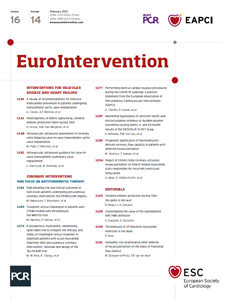
Primary percutaneous coronary intervention (PPCI) has been the preferred reperfusion strategy for patients with ST-elevation myocardial infarction (STEMI). However, in 2020, intravenous thrombolysis still remains a viable option for reperfusion. In European countries, long transportation time to PPCI has been the main indication for thrombolysis. Current clinical practice guidelines highlight the importance of the time interval from the first medical contact to the catheterisation laboratory admission1. If this is more than 120 minutes, a thrombolytic agent has to be administered first, followed by transport to the nearest catheterisation laboratory. Invasive assessment of the coronary arteries should be performed within 2-24 hours after thrombolysis and, if indicated, PPCI should be conducted.
In STEMI, mostly caused by atherothrombosis, a crucial role is played by platelets whose activity has to be efficiently blocked. In addition to aspirin, a P2Y12 inhibitor should be administered as soon as possible. Of the three oral P2Y12 inhibitors available, ticagrelor and prasugrel have shown a significantly faster and more pronounced effect on lowering platelet reactivity in comparison with clopidogrel2,3. In STEMI, on the other hand, ticagrelor and prasugrel have been sufficiently tested only in patients treated with PPCI or conservatively. Currently, clopidogrel is the only P2Y12 inhibitor recommended for patients treated not only with PPCI or conservatively but also with thrombolysis1.
Limited data supporting the administration of ticagrelor in patients treated with thrombolysis have been reported so far. The TREAT trial (Ticagrelor vs Clopidogrel After Fibrinolytic Therapy in Patients With ST-Elevation Myocardial Infarction), with a multicentre, randomised, open-label design, enrolled 3,799 patients (younger than 75 years of age). This was the first sufficiently powered trial aimed primarily at the safety of ticagrelor versus clopidogrel after the administration of thrombolysis (a fibrin-specific agent was used in 75.9%)4,5. A relatively young population (57.5% of white race) with a mean age of 58±9.5 years pretreated with clopidogrel was enrolled within 24 hours of symptom onset (median of 11.4 hours after fibrinolytic therapy to randomisation). The occurrence of the primary endpoint (Thrombolysis In Myocardial Infarction [TIMI] major bleeding at 30 days) was similar in both groups (0.73% vs 0.69%; p<0.001 for non-inferiority). Any bleeding events were found more often in the ticagrelor group of patients (5.38% vs 3.82%; p=0.02). At 12 months, the combined clinical outcome (cardiovascular mortality, myocardial infarction, or stroke) and major, fatal, and intracranial bleedings were similar, though the observations of clinical outcome have to be interpreted with caution because of the smaller number of patients compared to the PLATO trial (Ticagrelor versus clopidogrel in patients with acute coronary syndromes)3,6,7.
The MIRTOS trial (MIcrovascular integrity and left ventricular function Recovery after clopidogrel or TicagrelOr administration, in patients with STEMI treated with thrombolysis), conducted in Greece by Hamilos et al, and presented in this issue of EuroIntervention8, is the first study providing a direct comparison of ticagrelor and clopidogrel administered at the time of thrombolysis.
This multicentre, prospective, open-label and randomised controlled study comprised 335 patients <75 years old suffering from STEMI and treated with thrombolysis. The aim of the study was to compare the efficacy and safety of clopidogrel versus ticagrelor which were administered at the time of thrombolysis. The primary endpoint of the trial was the difference in post-PCI corrected TIMI frame count (CTFC) which it was possible to analyse in 154 (59.5%) out of 259 patients treated with PPCI. This surrogate endpoint correlating with microvascular damage was assessed by an independent core lab. This study was unable to demonstrate any significant differences between the clopidogrel (n=85) and ticagrelor (n=69) groups, either for CTFC (24.33±17.35 vs 28.33±17.59; p=0.10) or for major cardiovascular events (MACE) or major bleeding events (OR 2.0, 95% CI: 0.18-22.2; p=0.99). Contrary to expectations, these results indicate that the administration of ticagrelor in addition to thrombolysis and aspirin provides similar efficacy and safety to clopidogrel. However, all types of Bleeding Academic Research Consortium (BARC) bleedings including minor bleedings, types 1 and 2, were significantly higher (6.5% vs 1.8%; p=0.03) in the ticagrelor group of patients.
The generalisability of these results is subject to certain limitations. For instance, the time interval between thrombolysis and coronary angiography of 0-72 hours does not follow the current guidelines (2-24 hours) but reflects real-life practice. Hypothetically, this might favour ticagrelor as the more potent platelet P2Y12 receptor inhibitor compared to clopidogrel. Furthermore, it was only possible to analyse the CTFC as the primary endpoint in fewer than 60% of PPCI patients, mainly because of technical difficulties or insufficient image quality.
Recently, there has been a growing trend towards the timely performance of PPCI as the method of choice in patients with STEMI, due to its highly positive effects on mortality and quality of life. Together with the development of regional and especially nationwide 24/7 PPCI networks, it has become one of the most pronounced “miracles” of modern medicine. However, far too little attention has been paid to thrombolysis, despite the fact that it plays an important role not only in Greece but also in countries with large geographies.
Finally, the authors of the MIRTOS trial should be congratulated on a rather bold idea that was executed in a very professional way. The current study is hypothesis-generating and provides insights for further scientific research as well as a number of important implications for future practice.
Conflict of interest statement
P. Kala is a consultant for Boston Scientific; is on the speakers bureau for AstraZeneca, Boehringer Ingelheim and Edwards Lifesciences; and provides research support for Novartis, Zoll and Amgen.
Supplementary data
To read the full content of this article, please download the PDF.

